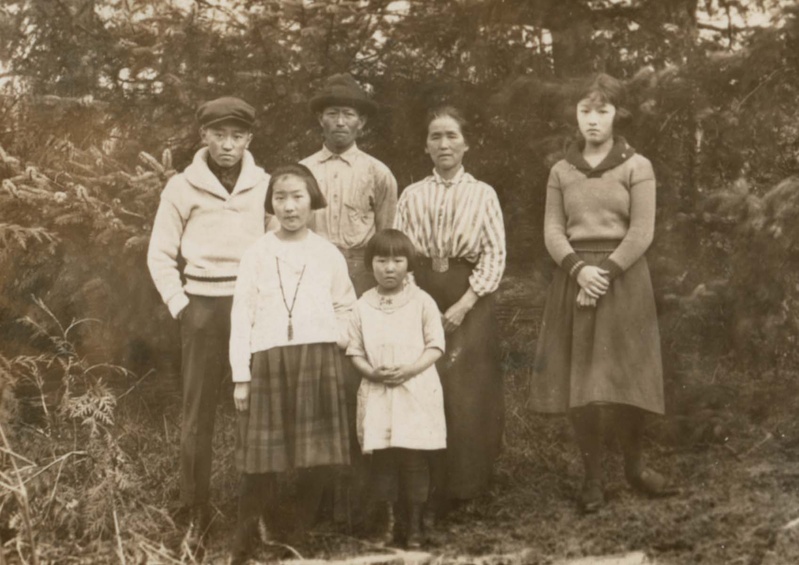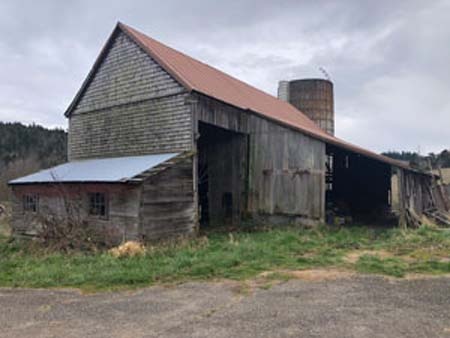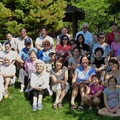At some point, Kaichi found an abandoned homestead next to Lake Leland that he wanted to buy. But under the state alien land law, Japanese citizens could not own land, nor could they become US citizens. However, the Kawamoto children were all US-born Americans. When Joe, the eldest, turned 12 in 1919, one of Kaichi’s Caucasian friends, George Thomas, became Joe’s legal guardian, enabling the $4000 purchase to be made in Joe’s name.
The property was 160 acres covered with second-growth trees as well as some fruit trees planted by the original homesteader. The only “improvement” was an old two-room log cabin that had saplings growing through its earthen floor. Kaichi cleared trees from around the cabin and put in a floor, windows and a door.
There was no electricity, but the cabin became home for the family. Kerosene lanterns provided light. For warmth at night, flatirons were heated over the wood stove, wrapped in fabric and put into beds. Family members washed themselves in washtubs. Later, Kaichi built a bathhouse with a tub.
At first, water came from a shallow well which Kaichi had dug. In 1924, Kaichi and Joe laid 2000 feet of pipe to bring in water from a spring farther away on the property. To provide more room, Kaichi built a second cabin for Joe and a third for his daughters to use as bedrooms.
Clearing enough of the remaining land to have a viable farm proved to be a long-term project. The hardest job was digging out the stumps left after felling trees. At first, Kaichi and Joe worked with a pick and shovel. Later, Kaichi bought a horse to pull out smaller stumps. Larger stumps were blasted out. Because Kaichi had an outside job until the mid-1920s and Joe had to go to school, the work progressed slowly. It wasn’t until 1937 that the two men cleared all the land they wanted to clear, about 29 acres.

Hauling out the cut timber became a family activity. The wood was cut into 54-inch lengths called “shingle bolts.” If they were large in diameter, they were split, so that one man could load them onto a sled. The sled was pulled by horse on a “skid road” made of poles laid on the ground and greased with oil.
Kaichi and Itsuno each sawed the logs into shingle bolts. Although Itsuno was only 4 feet 8 inches tall and weighed 85-90 pounds, she could handle the 7-foot saw by herself. Kaichi was not much bigger, at 5 feet 1 inch, 115 pounds. Their middle daughter, Pauline, kept the skids on the skid road greased, so that the horse could pull the sled more easily. Joe’s job was to load the bolts onto the sled, haul the sled to a railroad car, then load the bolts onto the car.
As the family made progress clearing the land, a garden was planted. In 1924, Kaichi built a barn (which still stands today). By 1926, the family had planted an orchard of apple, cherry, pear and plum trees, although birds usually ended up with most of the fruit. Clover and grass were sowed for the horse and the cows. Eventually, chickens and more cows were added.
If a farmer’s work is never done, neither is a farmer’s spouse’s work. In addition to the usual cooking, cleaning, sewing, laundering (with a tub and washboard), and ironing, Itsuno also took care of the children, tended the garden and cared for the chickens.
The children had chores, too. When Joe was 9 or 10, one of his jobs was to go by train to Quilcene to sell the eggs from his mother’s chickens and to pick up groceries. He also helped his father around the farm. In addition to other household chores, the girls learned how to sew; my mother’s least favorite job was hemming sheets by hand. (It must have been a great relief to both Itsuno and her daughters when the family was finally able to afford a Singer treadle sewing machine!). In the summer, everyone helped with haying.
Vacations were unheard of. But not everything was work. Kaichi bought Joe a bike when he was 9 or 10 years old. With Lake Leland next door, there was fishing. Joe and his lifelong friend Roscoe Thomas once used shingle bolts like paddle boards to go out into the middle of the lake. Later, Kaichi spanked Joe, although no one knows whether it was because the kids might have drowned or because they were wasting shingle bolts.
When the lake froze, children skated on the lake. At school, there were Christmas programs, spelling bees, and baseball even though there were not enough kids to field full teams. On Sundays, there was Sunday school. Traveling Chautauqua tent performances were also a treat. In the fall, the Kamamotos went to the county fair, where Jeanette once won a baby prize (presumably for being so cute). And it was at the fair where the family saw an airplane in flight for the very first time.
The Kawamotos were not the only Japanese in the area. In addition to men in the logging camps, families with names like Ishida, Ono, Funai, Doi, Tanemura, Nakagawa, Nakano, Iseri, and Shinozaki also lived in Leland or elsewhere in Jefferson County. The Kawamotos would get together with many of these families to celebrate New Year’s Day, the most important holiday in Japan. There would be a potluck feast, with food like sashimi and takenoko, and lots of homemade sake. Everyone would join in to pound mochi.
Joe graduated as valedictorian from Quilcene High School in 1924. His sisters were also excellent students, graduating from high school as either valedictorian or salutatorian. Joe and Alice yearned to go to college, but unfortunately, the family’s finances wouldn’t permit it.
By 1930, the Kawamotos were able to build a new house. For the first time, they could enjoy an indoor flush toilet and hot water heated by a wood-fired water heater. Electricity would have to wait a few more years. What differentiated their house from the usual American farmhouse was that its basement had an ofuro, a Japanese bath. What a pleasure it must have been to come in from a hard day’s work and soak in the hot water of the ofuro!

Marriages between Japanese Americans were “arranged” back then, although either party could opt out. In 1926, Jeanette had married an Issei, Eiichi “Eddie” Otsuka. Her marriage cost her American citizenship under a federal law that divested American women of their citizenship if they married citizens of certain countries. (The law did not apply to American men who married women from those countries). After the law was changed, Jeanette became a naturalized citizen in 1940.
The couple first lived in Tacoma, where Eddie worked as a mechanic in a garage and Jeanette went to school to become a beautician. They moved to Seattle in the late 1930s to manage hotels and apartment buildings.
*This article was originally published in The North American Post on July 28, 2023.
© 2023 Pamela A. Okano







